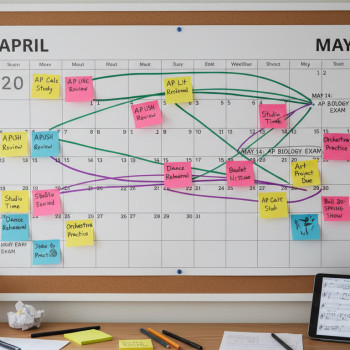Gap Year + AP: Turning a Pause into Purpose
When your child says they’re thinking about a gap year, a thousand questions rush into a parent’s mind: Will a pause hurt their college chances? Can they keep academic momentum? How do AP courses fit into the picture? The good news: taken thoughtfully, a gap year can be not just a neutral hiatus but a strategic advantage—especially when paired with Advanced Placement (AP) coursework or AP-aligned experiences.

Why families are rethinking the gap year
Gap years have shaken off their stereotype as aimless travel. Today’s gap years are more intentional: students pursue internships, research projects, community service, language immersion, or concentrated academic preparation. For many families, a gap year is about gaining clarity and maturity before the pressure cooker of college begins.
For parents, the primary concerns—academic continuity, competitiveness in admissions, and financial implications—are valid. But with planning, these concerns can be addressed while unlocking meaningful opportunities that enhance a student’s profile.
How AP courses and AP scores fit into the gap year narrative
AP classes serve two complementary roles when a gap year is being considered. First, AP coursework in high school demonstrates academic rigor—colleges view AP participation as an indicator that a student sought challenge. Second, AP exams create tangible evidence of subject mastery; high scores can translate into college credit or placement, freeing up budget and time later.
When a gap year is planned after high school graduation but before college enrollment, AP accomplishments help preserve the student’s academic momentum and academic story. If the gap year includes study, test prep, or research that builds on AP subjects, students can return to their college experience with sharper focus and a stronger sense of direction.
Three ways AP strengthens a gap year application narrative
- Demonstrated academic foundation: AP scores tell admissions officers you didn’t just cruise through high school—you mastered college-level content.
- Anchoring ambitious plans: If your child plans to pursue research, study abroad, or a specialized internship during a gap year, strong AP results reinforce their preparedness.
- Strategic savings or acceleration: College credit earned through AP exams can shorten time to degree, which families often value if a gap year might affect finances.
Designing a gap year that builds on AP strengths
Not all gap years are equal. A structured, reflective, and well-documented year will resonate with admissions officers and future employers more than an undirected break. Here’s how to design a gap year that leverages your child’s AP background.
1. Align experiences with AP subjects
If your student achieved strong AP scores in Biology and Chemistry, a gap year spent in a lab internship, a hospital volunteer program, or a field ecology project will feel coherent and purposeful. For AP English or History students, literary research, archival internships, or community education projects provide natural continuity.
2. Build measurable outcomes
Admissions officers and scholarship committees appreciate measurable achievements. Encourage your child to set goals like publishing a short paper, completing an online course with a certificate, collecting data for a community study, or creating a portfolio that demonstrates learning.
3. Keep academic skills sharp
A gap year doesn’t have to mean abandoning study. Short-term AP review modules, community college courses, or structured self-study can preserve essay writing, quantitative skills, and test stamina. This is where tailored support—like Sparkl’s personalized tutoring—can play a role: a few targeted sessions can maintain momentum, fill knowledge gaps, or produce stronger AP retakes when desired.
Admissions: How colleges view gap years
Most colleges accept gap years as long as students enroll as planned and provide a convincing explanation of how they used the time. Many institutions view a gap year positively if the student’s plans show maturity, self-directed learning, or service.
From an admissions standpoint, what matters is narrative coherence. Your child’s AP transcript and exam scores form one part of that narrative; the gap year activities form the next. Together, they tell a story about intellectual curiosity and growth.
Crafting the narrative: practical tips for parents
- Encourage documentation: journals, project summaries, photos, and recommendation letters from supervisors make a gap year tangible to admissions readers.
- Connect activities to long-term goals: even exploratory experiences should show how they helped clarify the student’s interests or skills.
- Balance exploration with responsibility: part-time work, internships, or community commitments show reliability and maturity.
Academic planning table: AP, Gap Year Activities, and Admissions Payoff
| AP Subject | Suggested Gap Year Activities | Admissions Value |
|---|---|---|
| AP Biology/Chemistry | Lab internships, field research, public health volunteer work | Shows research readiness, reinforces major-related commitment |
| AP English/Language or AP Literature | Freelance writing, editorial internships, community teaching | Demonstrates writing skill and communication aptitude |
| AP Calculus/Statistics | Data internships, coding bootcamps, economic research projects | Highlights quantitative reasoning and analytical rigor |
| AP History/Government | Archival research, civic engagement, policy internships | Signals civic mindedness and contextual thinking |
| AP Language (Spanish, French, etc.) | Language immersion, teaching assistant roles, translation projects | Shows cultural competence and communication skills |
Practical timeline: From senior year to campus
Below is a sample timeline that balances completing AP coursework and preparing for a purposeful gap year.
- Senior Year (Fall): Finish AP classes strongly. Finalize college deferral or gap year plan with the college admissions office if already accepted. Begin mapping gap year goals.
- Senior Year (Spring): Take AP exams or retakes if needed. Secure gap year placements (internships, volunteer positions). Create a budget and safety plan.
- Gap Year (Months 1–3): Onboard into placements, begin documenting experiences and learning outcomes.
- Gap Year (Months 4–9): Pursue a signature project (e.g., research paper, community program). Keep an academic routine—reading, short courses, or tutoring—to preserve skills.
- Gap Year (Months 10–12): Prepare final documentation, collect references, and complete any remaining academic commitments. Touch base with the college to confirm enrollment details.
Financial and logistical considerations
Families often worry about costs. A gap year doesn’t have to be expensive. Many meaningful activities—volunteer programs, local internships, or online learning—have low or no cost. Conversely, some immersive programs are costly; weigh their value against alternatives that deliver similar learning.
One pragmatic benefit: AP credits can reduce tuition costs once college starts, which may offset gap year expenses. If your child earns credit for AP scores, they may be able to graduate earlier or take lighter course loads in the first year—freeing time for internships or research that enhance long-term outcomes.
Safety, health, and feasibility
If the gap year involves travel or international placements, ensure health insurance, emergency plans, and reliable host organizations. For domestic options, verify organizational credentials and request references. Risk management makes the difference between an enriching year and an avoidable problem.
Keeping academic momentum without burnout
Parents rightly want their child to return to campus refreshed but not academically rusty. The trick is balance: keep core skills alive with low-pressure academic commitments.
- Set a weekly reading or problem set goal tied to AP subjects.
- Encourage short-term online courses or community college credits for structure.
- Use one-on-one tutoring strategically—Sparkl’s personalized tutoring is a good example of how targeted guidance can prevent skill erosion and help students refine study habits without overwhelming them.
Retaking AP exams or supplemental testing
Occasionally, students retake AP exams during a gap year to improve scores. That’s reasonable if the student needs a higher score for college credit or placement. A pragmatic approach: consult the college’s credit policies and weigh the time and stress of a retake against other gap year priorities.
Stories that illustrate impact
Consider these composite, real-world style examples that reflect common, successful paths families take.
- Maria, AP Biology and a Medical Internship: After earning high AP Biology and Chemistry scores in high school, Maria took a gap year at a local community hospital working as a volunteer technician. She kept an online lab skills course and met weekly with a science tutor for guidance. Her gap year experience deepened her medical interest and produced two strong recommendation letters.
- Dev, AP Calculus to Data Fellowship: Dev wanted hands-on data experience. He used his AP Calculus and Statistics background to secure a remote fellowship with a nonprofit, building dashboards and analyzing community data. The project led to a published report and a portfolio that impressed college admissions.
- Sofia, AP Language and Cultural Immersion: Sofia used her AP Spanish background to teach English to children while living with a host family abroad. Her language skills improved, and she produced a reflective project on bilingual education that she submitted to her college as part of her gap year summary.
How parents can support without steering the ship
Your role is to listen, help clarify goals, and provide practical scaffolding: financial planning, safety checks, and connections. Resist the urge to overcontrol. The most powerful outcomes come when students own their gap year choices and reflect on them with honest self-assessment.
Conversation starters
- What do you want to learn that high school didn’t offer?
- How will this year change your plans for college or career?
- What would a successful gap year look like to you in one sentence?
When to say yes—and when to pause
Say yes when the plan shows purpose, feasibility, and safety. Pause or adjust when plans are vague, financially risky without a safety net, or likely to produce isolation. A compromise is a structured local gap year: internships, community service, or hybrid programs that combine travel with coursework.
Putting it all together: A checklist for families
Use this checklist as you decide and plan:
- Confirm college deferral policies and enrollment steps.
- Map how AP scores will be used (credit, placement, or demonstration of rigor).
- Choose gap year activities aligned with AP strengths and future goals.
- Set measurable project goals and documentation strategies.
- Create a realistic budget and emergency plan.
- Plan for academic maintenance—short courses, readings, or tutoring.
- Gather references and keep an evidence trail for admissions essays.
Final thoughts: A gap year is a chapter, not a detour
When a gap year is intentional, documented, and connected to a student’s existing strengths—like AP coursework—it becomes more than a break. It becomes an inflection point that clarifies direction, deepens skills, and creates stories that matter to admissions officers and scholarship panels.
As a parent, your steady support—practical and emotional—lets your child take ownership of the experience. And when a student needs academic structure or focused skill-building during the year, personalized resources such as Sparkl’s tutoring can provide the right dose of guidance: 1-on-1 attention, tailored study plans, and expert tutors who help translate gap year experiences into polished narratives and stronger academic performance.

Gap years are not one-size-fits-all. But when thoughtfully woven together with AP achievements, clear goals, and reflective documentation, they can elevate a student’s profile and personal growth in ways that resonate far beyond college applications. Your child’s gap year can be a powerful chapter—where curiosity meets preparation, and experience becomes opportunity.
Ready to plan?
If you’d like practical next steps—templates for a gap year project plan, AP score planners, or a list of questions to help shape meaningful experiences—start a conversation with your child about priorities, and consider short, targeted tutoring sessions to shore up academic readiness. The right support helps turn a well-intentioned gap year into a strategically advantageous and deeply rewarding year.





















No Comments
Leave a comment Cancel